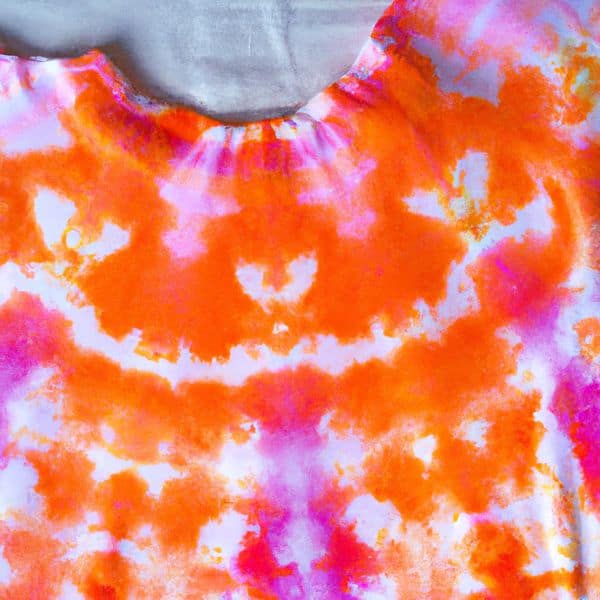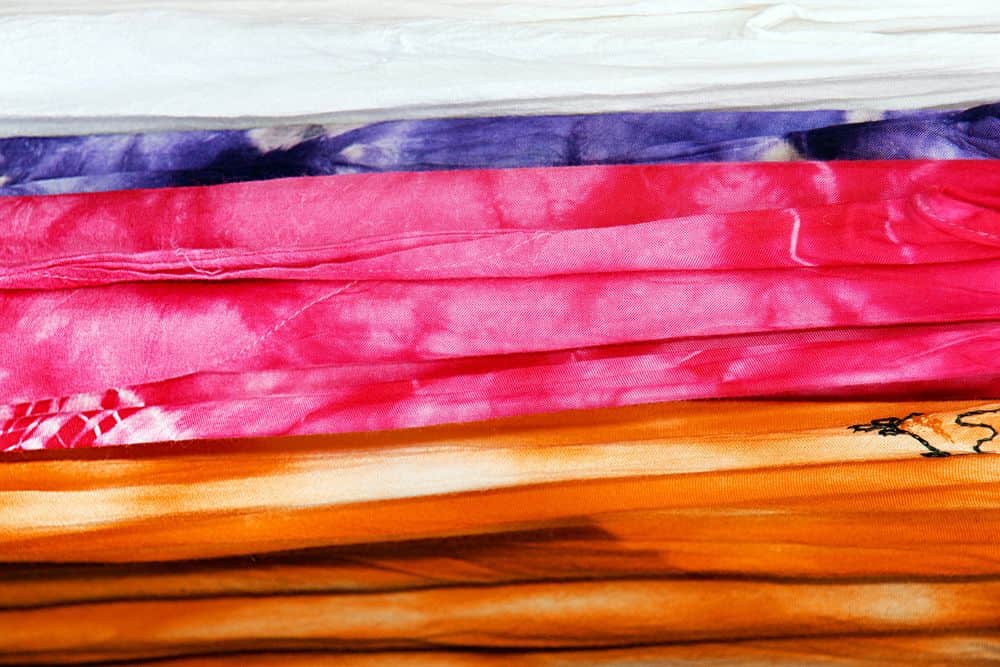Are you looking for the perfect material to tie dye your next project? Polyester might not be the first fabric that comes to mind, but it’s worth considering.
While cotton is a popular choice for tie dye due to its absorbency and natural fibers, polyester has some unique advantages as well. Firstly, polyester is known for its ability to hold vibrant colors. Unlike cotton which can sometimes fade or bleed after washing, polyester dyes tend to stay bright and bold even after multiple washes.
Additionally, polyester doesn’t shrink in the same way that cotton does when exposed to heat, so you don’t have to worry about your design becoming distorted over time. However, there are also some potential downsides to using polyester for tie dye such as difficulty getting the dye into the fiber and a lack of breathability compared to cotton.
In this article, we’ll dive deeper into whether or not polyester is a good option for your next tie dye project.
Is Polyester Good For Tie Dye
Polyester is a synthetic fabric that has been widely used in the textile industry for many years. It is known for its durability, wrinkle resistance, and easy maintenance.
However, when it comes to tie dyeing, polyester may not be the best choice of fabric. While it is possible to dye polyester using certain methods and dyes, the results are often unpredictable and may not be as vibrant or long-lasting as with natural fibers such as cotton or silk.
Additionally, because polyester is a non-porous material, it can be difficult for the dye to penetrate the fibers effectively, resulting in uneven coloring or fading over time. So if you’re looking to create vibrant and long-lasting tie-dyed garments, it’s generally better to stick with natural materials rather than attempting to dye polyester.
But what exactly happens when you do try to dye this synthetic material? Let’s take a closer look at the process and its outcomes.
What Happens When You Dye Polyester?
Although polyester is a popular fabric for clothing, it can be challenging to dye. Unlike natural fibers like cotton or silk, polyester does not absorb dye well because of its synthetic materials. When you try to tie-dye polyester, the colors may not come out as vibrant as they would on other fabrics. Additionally, the dye might not adhere correctly and could wash off easily after one or two washes.
So what happens when you dye polyester? The answer is that the color might appear faded or unevenly distributed, leaving your design looking less than perfect. However, there are ways to improve your results by using the right type of dye specifically designed for synthetic materials.
But what’s the best dye for polyester? Let’s find out in the next section!
Best Dye For Polyester?
If you are planning to tie dye on polyester fabric or a polyester blend, it’s important to use the right kind of dye for best results. Disperse dyes work well with polyester as they rely on a special dye carrier that helps penetrate the tightly woven fibers of synthetic fabrics.
Here are 3 things to keep in mind when choosing the best dye for your project:
- Look for disperse dyes specifically designed for synthetic fabrics like polyester.
- Choose colors that will contrast well against the color of your fabric, as disperse dyes tend to produce lighter shades than other types of dyes.
- Use hot water and high heat during the dyeing process to help open up the fibers and allow better penetration of the color.
When compared to cotton, polyester can be more challenging to dye due to its resistance to absorbing moisture and natural dyes. However, with the right materials and techniques, stunning results can still be achieved.
In the next section, we’ll explore some key differences between tie dying on cotton versus polyester fabrics.
Cotton Vs. Polyester Tie Dye
As discussed in the previous section, finding the best dye for polyester fabrics can be a challenge. However, tie-dyeing polyester is definitely possible and can produce vibrant and long-lasting designs.
It’s important to note that unlike natural fabrics such as cotton, polyester doesn’t absorb dyes easily because of its synthetic nature. To combat this issue, it’s recommended to use a dye carrier specifically designed for polyester or a polyester blend fabric. This will help the color adhere better to the fabric fibers during the dying process.
Additionally, while natural fabrics like cotton tend to work well with various types of dyes, it’s essential to follow specific instructions when working with polyester blends since they may require different methods of preparation before dyeing them.
In conclusion (oops!), if you’re looking to create unique patterns on your favorite polyester garments and accessories using tie-dye techniques, remember to choose an appropriate dye carrier and carefully read all instructions beforehand. Next up, we’ll explore how reverse tie-dyeing works on polyester materials!
Reverse Tie-Dye Polyester Fabric
Polyester fabric is a synthetic material that can be challenging to dye due to its resistance to water-based dyes.
However, it is possible to tie-dye polyester using disperse dyes specially formulated for synthetic fibers.
Reverse tie dyeing polyester involves removing the color from the fabric instead of adding new colors.
This technique works well on both pure polyester fabric and polyester blends as long as they are 100% synthetic fibers.
It’s essential to note that reverse tie-dyeing may not work effectively on blended fabrics containing natural fibers such as cotton or wool because these materials absorb bleach differently than synthetics.
In the subsequent section, we will explore whether you can tie-dye polyester with bleach and how this differs from traditional tie-dye techniques.

Can You Tie Dye Polyester With Bleach?
Polyester fabric and polyester blends are not the easiest materials to tie-dye, but it is possible to achieve vibrant colors with a little bit of effort. While regular dye will not adhere well to polyester fibers, there are special dyes on the market specifically designed for synthetic fabrics that will dye better.
However, if you want to add some unique texture and design elements to your polyester garment, you can try using bleach instead of traditional dye. Here’s how:
-
Start by diluting the bleach with water according to package instructions.
-
Use a spray bottle or sponge to apply the diluted bleach onto the desired areas of your polyester garment.
-
Let the bleach sit for about 10-20 minutes depending on how light you want the affected area to be.
-
Rinse out all the bleach thoroughly from your garment before washing it as usual.
Keep in mind that while bleaching gives an interesting effect, it may weaken the fibers over time so do this sparingly. If you’re more interested in full-on color customization though, consider buying dyes made specifically for synthetics instead!
Now let’s move onto whether or not you can tie-dye 50% cotton 50% polyester garments…
Can You Tie Dye 50% Cotton 50% Polyester?
While bleach may work on polyester fabric, it’s not the best option for tie-dyeing. Polyester is a synthetic material that doesn’t absorb dyes as well as natural fabrics like cotton or silk. However, if you’re determined to dye your polyester blend item, there are special types of dye made specifically for synthetics that will adhere better than traditional dyes.
It’s also worth noting that clothing made from a 50% cotton and 50% polyester blend will be easier to dye than just straight polyester because the cotton fibers help hold onto the color.
If you want your tie-dye design to come out vibrant and long-lasting, though, it’s recommended that you use natural fabrics instead of synthetics. Fabrics like cotton or rayon will take dye better and give you more consistent results.
In the next section, we’ll explore whether you can successfully tie-dye an 80% cotton and 20% polyester blend using different methods and techniques.
Tie Dye 80% Cotton 20% Polyester?
When it comes to tie-dyeing, many people wonder if polyester blends are suitable for this type of craft. The truth is that the percentage of polyester in a fabric plays an important role in the outcome of your project. In general, a higher percentage of cotton will result in brighter and more vibrant colors, while too much polyester can prevent the dye from fully penetrating the fibers. However, a 80% cotton 20% polyester blend can be a great option for tie-dyeing as long as you take some precautions.
Here are four tips to keep in mind when working with this type of fabric:
-
Pre-wash the material before starting your project to remove any sizing or finishes that may interfere with the dye.
-
Choose dyes specifically formulated for use on polyester-cotton blends.
-
Use hot water and allow the fabric to soak longer than you would with pure cotton.
-
Consider using a fixative after applying the dye to help set the color.
By following these steps, you should be able to achieve beautiful results with your 80% cotton 20% polyester blend fabric.
But what about fabrics with different percentages? Can you still tie-dye them successfully? Let’s find out in the next section…
You may find it interesting: Can You Tie Dye Microfiber
Can You Tie Dye 60% Cotton 40 Polyester?
While tie-dyeing 80% cotton and 20% polyester blend fabrics is a common practice, some may wonder if they can achieve the same vibrant results with a fabric that has a higher percentage of polyester.
The answer is yes – it’s possible to tie-dye polyester! However, there are a few things to keep in mind when dyeing synthetic materials like polyester.
Firstly, you’ll need to use disperse dye instead of the traditional fiber-reactive dyes used on natural fabrics like cotton. Disperse dye works by dispersing pigments into tiny particles that penetrate the surface of the fibers, rather than bonding chemically with them as reactive dyes do.
This means that your colors won’t be quite as bright or long-lasting as they would be on natural fabrics but will still produce beautiful results nonetheless. Additionally, because polyester doesn’t absorb water very well, it’s important to pre-treat the fabric before beginning the dyeing process to ensure even color distribution throughout the garment.
So while it may require a bit more preparation and patience compared to dyeing natural fabrics, tie-dyeing polyester blends can still yield stunning results for those willing to put in the extra effort.
Conclusion
In conclusion, tie-dye enthusiasts often ask if polyester is a good fabric for dyeing. The answer to this question is not straightforward because polyester does not absorb traditional dyes well due to its synthetic nature. However, with the use of specific types of dyes and techniques like reverse tie-dye or bleach dyeing, it is possible to achieve beautiful results on polyester fabrics.
It’s important to note that cotton remains the best fabric types for tie-dying as it absorbs dyes efficiently and produces vibrant colors.
Nevertheless, blending cotton with polyester can create durable clothing items with unique color patterns.
Ultimately, whether you decide to experiment with polyester or stick with cotton for your next tie-dye project depends on personal preference and desired outcomes.
